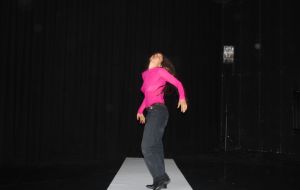Talk with Anna Franziska Jäger & Nathan Ooms on their new performance: "Modesta has a manic energy within her"
16 Sep 24
On October 2, 3 and 4, CAMPO kicks off the season with a CAMPO production: the highly anticipated new creation by Nathan Ooms & Anna Franziska Jäger. In Modesta (play of language and lips), their first group performance, Ooms & Jäger search in their own way for Modesta, a character from The Art of Joy, written by the Italian author Goliarda Sapienza. "The question of who Modesta is, is also the question that drives the performance itself."
How would you describe Modesta, and how does she appear in the performance?
Nathan: Modesta as the main character is an ambiguous concept because she’s more of a figure that appears, disappears, and takes on different forms expressed through text, movement and sound. The character is defined by a strong willpower,,, and zest for life . She finds a way to turn pain into pleasure. She has a strong ability to bend language to her will and thereby reverse certain ideas or conventions.
Modesta refers to the main character from the book The Art of Joy by Goliarda Sapienza, written in the 1960s, but we’ve completely removed her from that context: away from Sicily, away from the 20th century and also away from the format of the book. As a result, she has become more of an idea, that searches for a new form. The performance is a proposal for that.
We moved away from the realism of the book and started to play with language itself, hence the subtitle of our piece: play of language and lips. In that sense, the performance is a search for Modesta, where we hope to take the audience along with us somehow. The question of who Modesta is, is also the question that drives the performance itself.
How did you come across the book?
Anna Franziska: I happened to come across it in an online post, with the caption: ‘can't put this book down’. I started reading it and became fascinated. Modesta triggered me; the way she thinks, how she has ‘character’. She must have been a strange being for her time, but maybe even more so today. She has pleasure in living, a kind of unconditional love for life. But you can’t exactly pinpoint where that comes from. She has a kind of manic energy within her.
The author Goliarda Sapienza of the book had quite a turbulent life, and it sometimes seems that she wrote the book because perhaps she couldn’t or didn’t want to be that character herself. The book seems a sort of obsessive affirmation of life. In that sense, taking this book as a departing point someway contrasts with our previous work, where characters were stuck in something, perhaps themselves. Modesta, on the other hand, actively wants to place herself in the world, guided by her desire.
Would you recommend others to read the book as well?
Anna Franziska: Absolutely!
Nathan: Even after seeing our performance, you can still read the book without feeling any sense of repetition. The show is an interpretation, its own imagination around Modesta, which leaves much of the book untouched.
You’re working again with Carly Rae Heathcote on costumes and set design, and with Lander Gyselinck on music and for dramaturgy with Bojana Cvejić. How do they contribute to the atmosphere of the performance?
Nathan: We have developed an intimate relationship with Carly throughout the collaborations and she is always closely involved in the whole of our ‘undertaking’. We work from a shared imagination, and the visual character thus develops in parallel with the text and choreography. At the same time, she brings in unexpected elements for us that challenge our thinking about the performance.
Anna Franziska: Lander is a fantastic musician with a lot of ideas about what music can mean in theatre. His music hovers between the melancholic and the euphoric. There’s a lot of energy in that? contrast.
Nathan: As we’re telling an elliptical life story, the passing of time is a recurring theme in the music. Besides creating the music, he challenges us to think musically about, for instance, the texts and to create an interaction between the two.
Anna Franziska: This is the third time we have worked with Bojana as a dramaturge and she is always an inspiring and critical interlocutor during the different stages of the process, both in terms of content and working methods. She challenges us to keep thinking clearly, especially when the chaos and multiplicity of the creation process are overwhelming.
The fact that we are on stage together with Christine De Smedt, Arthur Loontjens, and Rosie Sommers is of undeniable importance. That group as collective energy is essential in our search for Modesta. It’s not one person playing one character; the character emerges through the connection between different performers.
This isn’t your first collaboration, you created together Bartlebabe (2021), Ambient Theatre Fury (2022) en DONKEY (2023). What makes you complement each other so well as artists?
Anna Franziska: We enjoy working together because we manage to align our complementary desires. These are desires related to abstraction and form on one hand, and fiction and the creation of characters and storytelling on the other. Nathan has a more choreographic imagination, I perhaps more of a theatrical one. These different interests challenge each other, and as a result, there’s always something that surprises us in one another, which keeps us searching. Not always easy, but always an invitation to work together.
